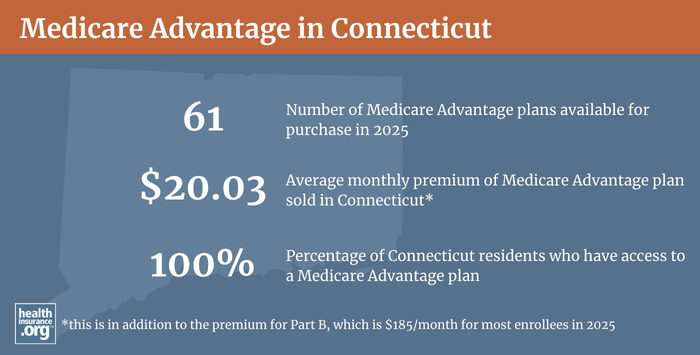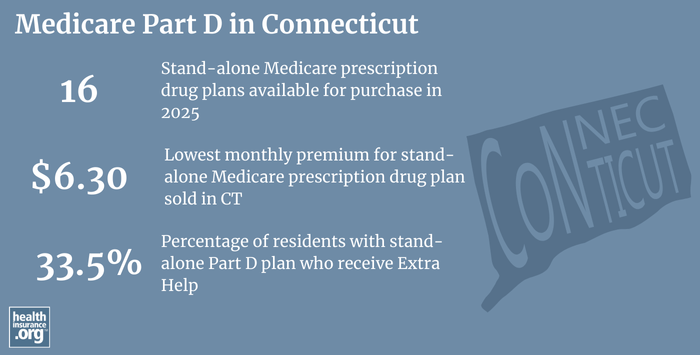Medicare in Connecticut

Connecticut has among the strongest Medigap consumer protections laws in the country
Key Takeaways
- More than 700,000 residents are enrolled in Medicare in Connecticut.1
- Over half of Connecticut Medicare beneficiaries have Medicare Advantage plans.1
- All counties in Connecticut have Medicare Advantage plans available for 2024.2
- 12 insurers offer Medigap plans in Connecticut; all plans are guaranteed-issue and community-rated at all times.3
- There are 16 stand-alone Medicare Part D prescription plans available in Connecticut for 2025, with premiums that start at $6.30 per month.4

Medicare enrollment in Connecticut
As of July 2024, Medicare enrollment in Connecticut stood at 743,093 people, amounting to about 19% of the state’s population.1 As is the case nationwide, Medicare enrollment in Connecticut is comprised mostly of people who are eligible due to their age (i.e., being at least 65).
But younger Americans gain Medicare eligibility after they have been receiving disability benefits for 24 months, or have ALS or end-stage renal disease. In Connecticut, almost 10% of beneficiaries are eligible due to disability rather than age.1
Medicare options
Medicare beneficiaries can choose from among several options to access Medicare coverage. The first choice is between Medicare Advantage, where an individual enrolls with a private health plan that is under contract with the federal government to provide Medicare coverage, or Original Medicare, where benefits are paid directly by the federal government. Medicare beneficiaries also have options around Medigap policies and Medicare Part D (prescription drug) coverage.
Original Medicare includes Medicare Part A (also called hospital insurance, which helps pay for inpatient stays at a hospital, skilled nursing facility, or hospice center) and Medicare Part B (also called medical insurance, which helps pay for outpatient care like a doctor appointment or a preventive healthcare service, such as most vaccinations). Medicare Advantage plans bundle Parts A and B under a single monthly premium and often include other services like prescription drugs and vision coverage.
Private Medicare Advantage plans are an alternative to Original Medicare. There are pros and cons to either option, and the right solution is different for each person.
Learn about Medicare plan options in Connecticut by contacting a licensed agent.



Explore our other comprehensive guides to coverage in Connecticut

We’ve created this guide to help you understand the Connecticut health insurance options available to you and your family, and to help you select the coverage that will best fit your needs and budget.
Learn about health insurance coverage options in Connecticut.


Hoping to improve your smile? Dental insurance may be a smart addition to your health coverage. Our guide explores dental coverage options in Connecticut.


Learn about Connecticut’s Medicaid expansion, the state’s Medicaid enrollment and Medicaid eligibility.


Short-term health plans provide temporary health insurance for consumers who may find themselves without comprehensive coverage. Learn more about short-term plan availability in Connecticut.
Learn about short-term insurance regulations in Connecticut.

Frequently asked questions about Medicare in Connecticut
What is Medicare Advantage?
Nationwide, 50% of all Medicare beneficiaries are enrolled in Medicare Advantage plans as of July 2024.5
Medicare Advantage enrollment in Connecticut is slightly higher than the national average at 57%.1
Medicare’s annual election period/open enrollment period (October 15 to December 7 each year) allows Medicare beneficiaries the chance to change between Medicare Advantage and Original Medicare (and add, drop, or switch to a different Medicare Part D prescription plan). And people who are already enrolled in Medicare Advantage also have the option to update their Medicare Advantage plan selection or switch to accessing benefits under Original Medicare during the Medicare Advantage open enrollment period, which runs from January 1 to March 31.

What are Medigap plans?
Original Medicare does not limit out-of-pocket costs, so most enrollees maintain some form of supplemental coverage. For those who don’t have access to supplemental employer-sponsored coverage or Medicaid, Medigap plans (also known as Medicare supplement plans, or MedSupp) will pay some or all of the out-of-pocket costs they would otherwise have to pay if they had only Original Medicare.
There are 12 insurers that offer Medigap plans in Connecticut in 2025.3
Although Medigap plans are sold by private insurers, the plans are standardized under federal rules, with ten different plan designs (differentiated by letters, A through N). The benefits offered by a particular plan (Plan G, Plan K, etc.) are the same regardless of which insurer sells the plan.
Prices vary from one insurer to another, but Connecticut law (Chapter 700c, Section 38a-473) requires insurers to use community rating: rates cannot vary based on age, gender, or health status.
Unlike other private Medicare coverage (Medicare Advantage and Medicare Part D plans, which cover prescription drugs), federal rules do not grant an annual open enrollment window for Medigap plans. Instead, federal rules provide a one-time six-month window when Medigap coverage is guaranteed-issue, starting when a person is at least 65 and enrolled in Medicare Part B. But consumer protections are much stronger in Connecticut: All Medigap plans in Connecticut are sold on a guaranteed-issue basis at all times, and with community rating. So Connecticut residents have the option to switch from one Medigap plan to another, regardless of their health.
People who aren’t yet 65 can enroll in Medicare if they’re disabled and have been receiving disability benefits for at least two years (the 24-month wait does not apply if they have ALS or end-stage renal disease), and about 9% of Connecticut Medicare beneficiaries are under age 65.1 Federal rules do not guarantee access to Medigap plans for people who are under 65, but the majority of the states — including Connecticut — have implemented rules to ensure that disabled Medicare beneficiaries have at least some access to Medigap plans.
Under Connecticut law (Chapter 700c, Section 38a-495c) Medigap insurers that offer Plans A, B, and D (or C if the beneficiary became eligible for Medicare prior to 2020) must offer those plans to disabled beneficiaries under age 65. This page shows which plans each insurer offers; note that many of them do not offer plans B, D, or C, meaning that the only plan they would offer to beneficiaries under 65 would be Plan A.
What is Medicare Part D?
Original Medicare does not provide coverage for outpatient prescription drugs. This gap in coverage was addressed under the Medicare Modernization Act of 2003, which was signed into law by President George W. Bush.
More than half of Original Medicare beneficiaries nationwide have supplemental coverage via an employer-sponsored plan (from a current or former employer or spouse’s employer), and these plans often include prescription coverage. Medicare beneficiaries who do not have drug coverage through an employer-sponsored plan can enroll in a Medicare Part D plan to get coverage for prescriptions (beneficiaries who are dual-eligible for Medicare and Medicaid also get their drug coverage through Part D, rather than through Medicaid).
Medicare Part D enrollment is available via stand-alone plans (prescription drug plans — PDPs) or via integrated Medicare Advantage and prescription drug plans (MAPDs).
There are 16 stand-alone Medicare Part D plans available in Connecticut for 2025 coverage, with premiums that start at $6.30/month.4
More than 620,000 Medicare beneficiaries in Connecticut had Part D coverage as of July 2024.1 As of late 2020, Part D coverage in Connecticut had been split nearly equally between stand-alone Part D plans (PDPs) and Medicare Advantage plans with integrated Part D coverage (MA-PDs). But by mid-2024, the balance had tipped significantly in favor of MA-PDs. At that point, about 405,545 Connecticut Medicare beneficiaries had Part D coverage via MA-PDs, while only about 219,818 had stand-alone PDP coverage.1
Stand-alone Medicare Part D enrollment has been decreasing in Connecticut (as has been the case in many states), while enrollment in Part D coverage integrated with Medicare Advantage plans has been increasing. This is due to the increase in the percentage of Medicare beneficiaries — in Connecticut and nationwide — who are choosing Medicare Advantage plans.

How does Medicaid provide financial assistance to Medicare beneficiaries in Connecticut?
Many Medicare beneficiaries receive financial assistance through Medicaid with the cost of Medicare premiums, prescription drug expenses, and services not covered by Medicare – such as long-term care.
Our guide to financial assistance for Medicare enrollees in Connecticut includes overviews of these benefits, including Medicare Savings Programs, long-term care coverage, and eligibility guidelines for assistance.
What additional resources are available for Medicare beneficiaries and their caregivers in Connecticut?
These resources provide free assistance and information about Medicare programs and availability in Connecticut.
- CHOICES (Connecticut’s program for Health insurance assistance, Outreach, Information and referral, Counseling, Eligibility Screening) answers questions about Medicare coverage in Connecticut.
- Our guide to Medicare’s annual open enrollment period is a summary of what you need to know about the fall enrollment window for Medicare Part D plans and Medicare Advantage plans.
- Connecticut’s overview of Medicare Savings Programs is helpful for Connecticut Medicare beneficiaries with modest incomes and assets.
- The Medicare Rights Center website provides information geared to Medicare beneficiaries, caregivers, and professionals.
Louise Norris is an individual health insurance broker who has been writing about health insurance and health reform since 2006. She has written dozens of opinions and educational pieces about the Affordable Care Act for healthinsurance.org.

Looking for more information about other options in your state?
Need help navigating health insurance options in Connecticut?
Explore more resources for options in Connecticut including ACA coverage, short-term health insurance, dental insurance and Medicaid.
Speak to a sales agent at a licensed insurance agency.
Footnotes
- “Medicare Monthly Enrollment – Connecticut.” Centers for Medicare & Medicaid Services Data. Accessed November, 2024. ⤶ ⤶ ⤶ ⤶ ⤶ ⤶ ⤶ ⤶
- ”Medicare Advantage 2024 Spotlight: First Look” KFF.org Nov. 15, 2023 ⤶
- “Explore your Medicare coverage options.” Medicare.gov. Accessed October, 2024. ⤶ ⤶
- ”Fact Sheet: Medicare Open Enrollment for 2025” (20) Centers for Medicare & Medicaid Services. Sep. 27, 2024 ⤶ ⤶
- “Medicare Monthly Enrollment – National.” Centers for Medicare & Medicaid Services Data. Accessed November, 2024. ⤶

